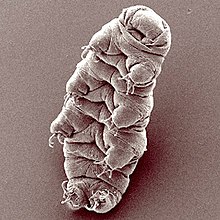| Eutardigrade Temporal range:
| |
|---|---|

| |
| Hypsibius dujardini | |
|
Scientific classification
| |
| Domain: | Eukaryota |
| Kingdom: | Animalia |
| Phylum: | Tardigrada |
| Class: | Eutardigrada |
| Orders, superfamilies and families | |
| |
Eutardigrada are a class of tardigrades (Tardigrada) without lateral appendages. Primarily freshwater bound, some species have secondarily gained the ability to live in marine environments ( Halobiotus). By cryptobiosis many species are able to live temporarily in very dry environments. More than 700 species have been described. [2]
The order Apochela consists of only one family, Milnesiidae, with two genera: Milnesium and Limmenius. Milnesium tardigradum can be found worldwide and is one of the biggest species among tardigrades (up to 1.4 mm); similar-looking species have been found in Cretaceous amber. [1] The mouth of this predator has a wide opening, so the animal can eat rotifers and larger protists. Other eutardigrades belong to the order Parachela.
References
- ^ a b Budd, G. (2001). "Tardigrades as 'Stem-Group Arthropods': The Evidence from the Cambrian Fauna". Zoologischer Anzeiger. 240 (3–4): 265–279. doi: 10.1078/0044-5231-00034. ISSN 0044-5231.
- ^ Zhang, Z.-Q. (2011). "Animal biodiversity: An introduction to higher-level classification and taxonomic richness" (PDF). Zootaxa. 3148: 7–12. doi: 10.11646/zootaxa.3148.1.3.
External links
-
 Data related to
Eutardigrada at Wikispecies
Data related to
Eutardigrada at Wikispecies - "Eutardigrada". Integrated Taxonomic Information System.
- Tardigrade taxa
- Pseudobiotus megalonyx
- Milnesium tardigradum (radiation experiments)
| Eutardigrade Temporal range:
| |
|---|---|

| |
| Hypsibius dujardini | |
|
Scientific classification
| |
| Domain: | Eukaryota |
| Kingdom: | Animalia |
| Phylum: | Tardigrada |
| Class: | Eutardigrada |
| Orders, superfamilies and families | |
| |
Eutardigrada are a class of tardigrades (Tardigrada) without lateral appendages. Primarily freshwater bound, some species have secondarily gained the ability to live in marine environments ( Halobiotus). By cryptobiosis many species are able to live temporarily in very dry environments. More than 700 species have been described. [2]
The order Apochela consists of only one family, Milnesiidae, with two genera: Milnesium and Limmenius. Milnesium tardigradum can be found worldwide and is one of the biggest species among tardigrades (up to 1.4 mm); similar-looking species have been found in Cretaceous amber. [1] The mouth of this predator has a wide opening, so the animal can eat rotifers and larger protists. Other eutardigrades belong to the order Parachela.
References
- ^ a b Budd, G. (2001). "Tardigrades as 'Stem-Group Arthropods': The Evidence from the Cambrian Fauna". Zoologischer Anzeiger. 240 (3–4): 265–279. doi: 10.1078/0044-5231-00034. ISSN 0044-5231.
- ^ Zhang, Z.-Q. (2011). "Animal biodiversity: An introduction to higher-level classification and taxonomic richness" (PDF). Zootaxa. 3148: 7–12. doi: 10.11646/zootaxa.3148.1.3.
External links
-
 Data related to
Eutardigrada at Wikispecies
Data related to
Eutardigrada at Wikispecies - "Eutardigrada". Integrated Taxonomic Information System.
- Tardigrade taxa
- Pseudobiotus megalonyx
- Milnesium tardigradum (radiation experiments)